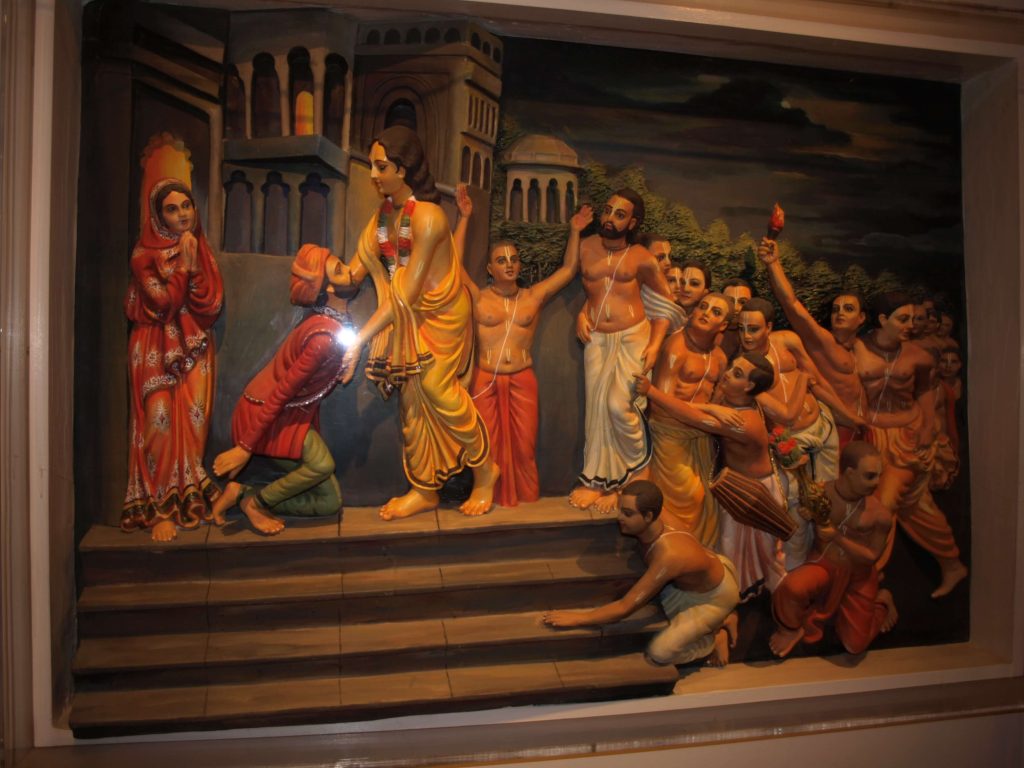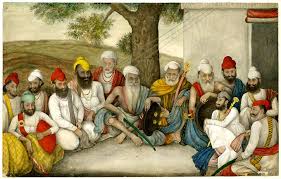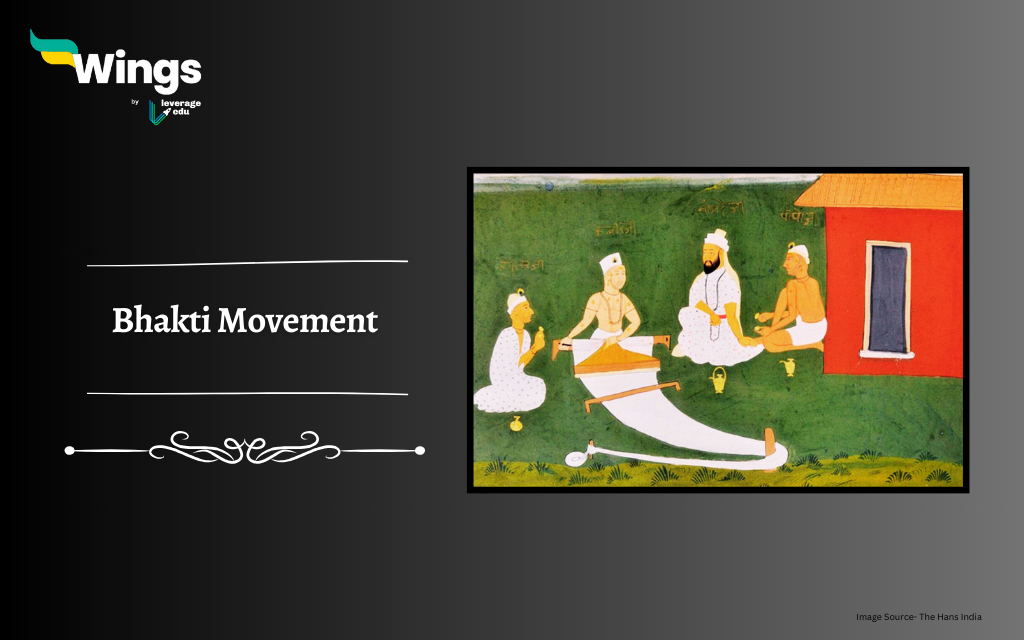The Bhakti Movement was a religious reform movement in medieval times that started in the 7th and 10th centuries in the South Indian states of Kerala and Tamil Nadu and spread all over the world. At first, it emphasised the single path to the devotion of God. The movement was on the basis of the doctrine that it is through love and worship that the relationship between god and man is based, and not through performing any religious ceremonies or rituals. In this blog, we will delve into the origin, causes and effects.
Contents
Who started the Bhakti Movement?
The origin of the movement can be traced back to the Vedas, but the development activities took place after the 7th century. The initiative was from Shaiva Nayanars and Vaishnavite Alwars in South India.
- Earliest roots are traced back to South India, especially among the Alvars (devotees of Vishnu) and Nayanars (devotees of Shiva) around the 6th century CE.
- The movement gradually spread to North India by the 13th century through poet-saints.
- Ramanuja, a 12th-century philosopher, gave philosophical foundations to Bhakti through Vishishtadvaita Vedanta.
- In the North, Sant Kabir, Guru Nanak, Ravidas, Meerabai, and Tulsidas became iconic Bhakti saints.
- They preached in local languages, making spirituality accessible to common people.
- Bhakti leaders opposed caste discrimination and ritualism, focusing on personal devotion and social equality.
- Their teachings were often delivered in the form of poems, songs, and bhajans.
| Places | Famous Bhakti Movements | Saints |
| Karnataka | Virashaivism/Sharana Movement | Akkamahadevi, Basavanna, Allama Prabhu |
| Tamil Nadu & Kerala | Vaishnavism Movement | Nayanars (devotees of Shiva) and Alvaras (devotees of Vishnu) |
| Maharashtra | Varkari | Namdev, Tukaram and Jnanadev |
| Northern India | Vaishnavism Movement | Surdas, Kabir Das,Dadu Dayal,Guru Nanak, Ravi Das, Ram Das,Meerabai, etc |

How did the Bhakti Movement Start?
The Bhakti Movement began in India around the 7th century as a spiritual revolt against rigid rituals, caste divisions, and priestly dominance in Hindu society. Here are the Key Points on the Start of the Bhakti Movement:
- Originated in South India: The movement first took shape with Alvars (devotees of Vishnu) and Nayanars (devotees of Shiva) in Tamil Nadu.
- Rejection of Ritualism: It opposed complicated Vedic rituals and emphasised personal devotion (bhakti) over priestly control.
- Spiritual Equality: Saints preached that God is for all, regardless of caste, gender, or background.
- Local Languages Used: Bhakti saints used regional languages like Tamil, Kannada, Marathi, and Hindi to reach common people.
- Songs and Poetry: Devotion was expressed through bhajans, kirtans, and verses, making spirituality more accessible.
- Criticism of Social Injustice: Many Bhakti leaders stood against untouchability and social inequality, promoting a more inclusive form of worship.
- Focus on a Personal God: Bhakti emphasised direct connection with a personal deity—like Vishnu, Shiva, or Krishna—over abstract philosophy.
- Spread to North India: From the 12th century onwards, it moved north with saints like Kabir, Meera Bai, and Tulsidas leading the wave.
- Influenced by Sufism: The Bhakti Movement was shaped by Sufi teachings, especially in promoting love, peace, and surrender to God.
- A Mass Movement: Over time, it became a pan-India cultural revolution, deeply influencing art, literature, and religious life.
Also Read –What is the Difference Between Nayanars and Alvars?
What were the features of the Bhakti Movement?
The Bhakti Movement was a spiritual and social reform movement in India that emphasized love, devotion to a personal god, equality, and rejection of caste-based discrimination and ritualistic practices. Some of the features of the movement are –
- Though known by different names, the unity of God or one God.
- Strong condemnation of various blind faiths, ritualistic practices and ceremonies.
- Rejection of the belief in Idol worship
- Realization of God’s prevalence and Surrender of oneself to the Ultimate reality, i.e. God.
- Rejection of the caste division and belief in the equality of all human beings.
- Salvation is only through the path of bhakti.
- Wide horizon and open-minded thoughts about religious matters.
- Use of local language or vernacular language for preaching
- Creation of literature in vernacular languages.
- Emphasis on Nirguna and Saguna bhakti
| Nirgun | Prema-Shrayi was the bhakta’s poetry, which meant roots in love. |
| They believed in the invisible formless god, who is without attributes. | |
| Some Nirgun Saints are – Guru Nanak, Kabir, etc | |
| Sagun | Jnana-Shrayi was the bhakta’s poetry, which meant they had their roots in knowledge |
| Prema-Shrayi was the bhakta’s poetry which meant roots in love. | |
| Some Sagun Saints are – Surdas, ,Meerabai, Tulsidas, etc |
Vedanta Saints and Their Contribution
Vedanta saints played a vital role in shaping Indian philosophy. They simplified complex spiritual ideas, promoted self-realisation, and inspired generations through their teachings, devotion, and pursuit of ultimate truth. Some of the Vedantic Saints and their contribution to the Bhakti movement are –
| Vedanta Saints | Contribution |
| Adi Shankaracharya | Consolidated the Doctrine of Advaita Vedanta (Non-Dualism). |
| Emphasised that there exists a distinction between Atman( Soul) and Brahman (ultimate reality). | |
| Ramanujacharya | Founded the Vishishtadvaita Vedanta or Qualified Monism |
| Emphasized that there exists a distinction between Atman( Soul) and Brahman (ultimate reality). | |
| Nimbarka | Introduced the theory of Bhed-Abheda (Different &Non-Different) |
| Believed that the Supreme, soul and the world were identical and yet different | |
| Madhavacharya | Preached “Dvaita or Dualism” |
| Interpreted that divinity was separate from the soul or human consciousness | |
| Nathpanthis, Yogis and Siddhas | Advocated renunciation of the world |
| To them, salvation lay in meditation on the formless god. |
Sharana/ Virashaivism Movement
The Sharana or Virashaivism Movement began in the 12th century in Karnataka, promoting equality, devotion to Lord Shiva, and rejection of caste and ritualism through the teachings of Basavanna and other saints. Here are the key points on Sharana/ Virashaivism Movement
- It was initiated by Basavanna and some other virashaivas like Akkamahadevi and Allama Prabhu.
- They supported the equality of all human beings and fought against the Brahmanical ideas of caste and the poor treatment of women.
- They also rejected idol worship and religious rituals.
- Their belief encouraged post-puberty marriage and widow remarriage and challenged the caste distinction, also questioning the theory of rebirth.
- Basavanna preached his ideologies mostly through poetry, which were known as Vachanas.
- He established the Anubhava Mantapa(1st democratic parliament of the world). It was an academy for philosophers, saints and mystics of the Ligayath’s faith.
Also Read – Vedanta Philosophy: History, Schools & Significance
Varkari Tradition
Varkari is a religious movement which is associated with the geographical location of Maharashtra and northern Karnataka. The Sampradaya was a tradition prevalent within the bhakti spiritual tradition of Hinduism. The term, Varkari in the Marathi language of Maharashtra, means “Pilgrim” and Vari means “Pilgrimage”.
- Originated in Maharashtra, centred around the worship of Lord Vithoba of Pandharpur.
- “Varkari” means “pilgrim” – followers undertake an annual pilgrimage called Wari to Pandharpur.
- Emphasizes Bhakti (devotion) over rituals and caste distinctions.
- Promotes simple living, honesty, humility, and community service.
- Followers sing Abhangs – devotional poetry composed by saints like Sant Tukaram and Sant Dnyaneshwar.
- Encourages equality of all beings, rejecting discrimination based on caste or gender.
- Focuses on spiritual discipline, vegetarianism, and non-violence.
- Plays a vital role in preserving Marathi literature and culture.
- Continues to influence Maharashtra’s social and religious identity even today.
- A living example of peaceful spiritual movement based on inner devotion and collective harmony.
Also Read – Arya Samaj: History, Founder, Features, Significance
What was the Impact of the Bhakti Movement?
The effect of the movement was felt across the nation and among wider masses. Some of the impacts are –
- Practices like Sati Pratha and Caste rigidities were questioned, and the bhakti saints also became the torchbearers of Social Reforms.
- Women’s presence on the path of devotion and kirtan, like Laila (Kashmir), Mirbai and Anda,l was strongly supported and is popular even today.
- Instead of the Sanskrit language, Bhakti saints preached through the medium of their vernacular languages, which could be understood very easily.
- It popularised the idea of social giving like Seva and Dana.
- Preached an inclusive path to spiritual salvation along with the message of Ahimsa.
- Rulers adopted liberal religious policies under the impact of the Bhakti movement.

FAQs
The Bhakti movement did not have a single founder; it was a widespread devotional trend that emerged in different regions of India at various times. Its roots can be traced to the Alvars and Nayanars in South India, with various saints contributing to its spread over centuries.
Three core principles of the Bhakti movement include: intense devotion (bhakti) to a personal God, rejection of elaborate rituals and caste distinctions, and the belief that salvation could be achieved through love and surrender to God.
While interpretations vary, five general principles of Bhakti often include: intense devotion to a chosen deity, selfless action (karma yoga), spiritual knowledge (jnana), detachment from worldly desires, and the guidance of a spiritual teacher (guru).
For Class 7, notes on the Bhakti movement typically cover its origin in South India, spread to the North, prominent saints like Kabir, Nanak, and Chaitanya Mahaprabhu, its emphasis on equality and devotion, and its impact on Indian society and culture.
The main goal of the Bhakti movement was to achieve spiritual liberation and a direct connection with God through personal devotion and love, rather than through complex rituals or strict caste hierarchies. It emphasized inner purity and equality among devotees.
Relevant Blogs
| Wahabi Movement: History, Objectives & Impact | Sufi Movement |
| All the Names of India Throughout History | Jain Councils |
| 100+ Rumi Quotes on Love, Life, Nature & the Universe | Gautam Buddha |
That’s all about the Bhakti Movement! If you want to know more about topics like this, then visit our general knowledge page! Alternatively, you can also read our blog on general knowledge for competitive exams!
 One app for all your study abroad needs
One app for all your study abroad needs














